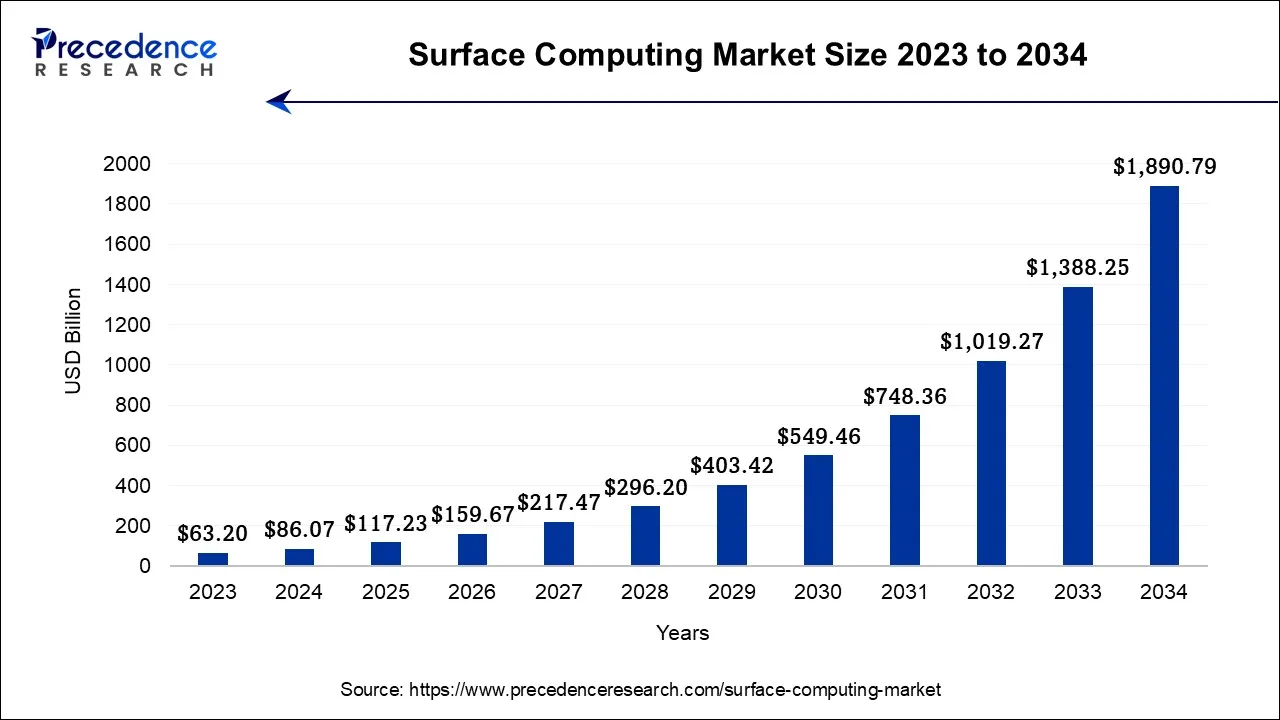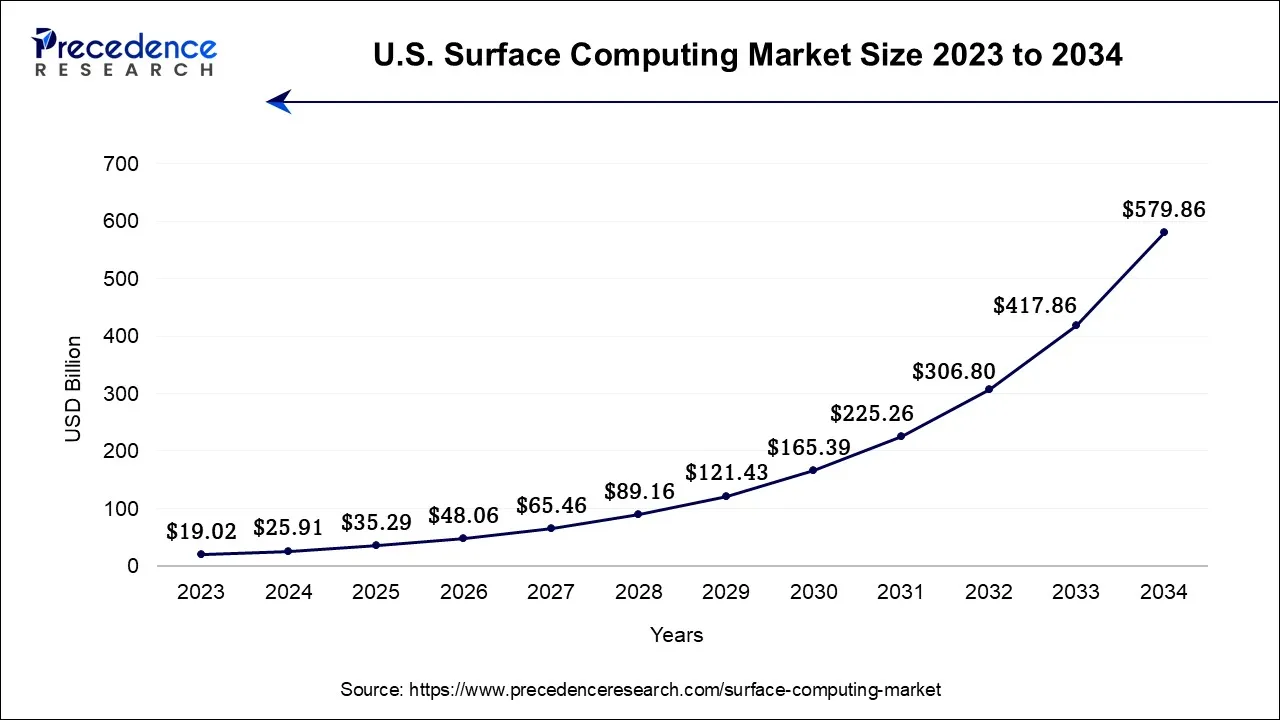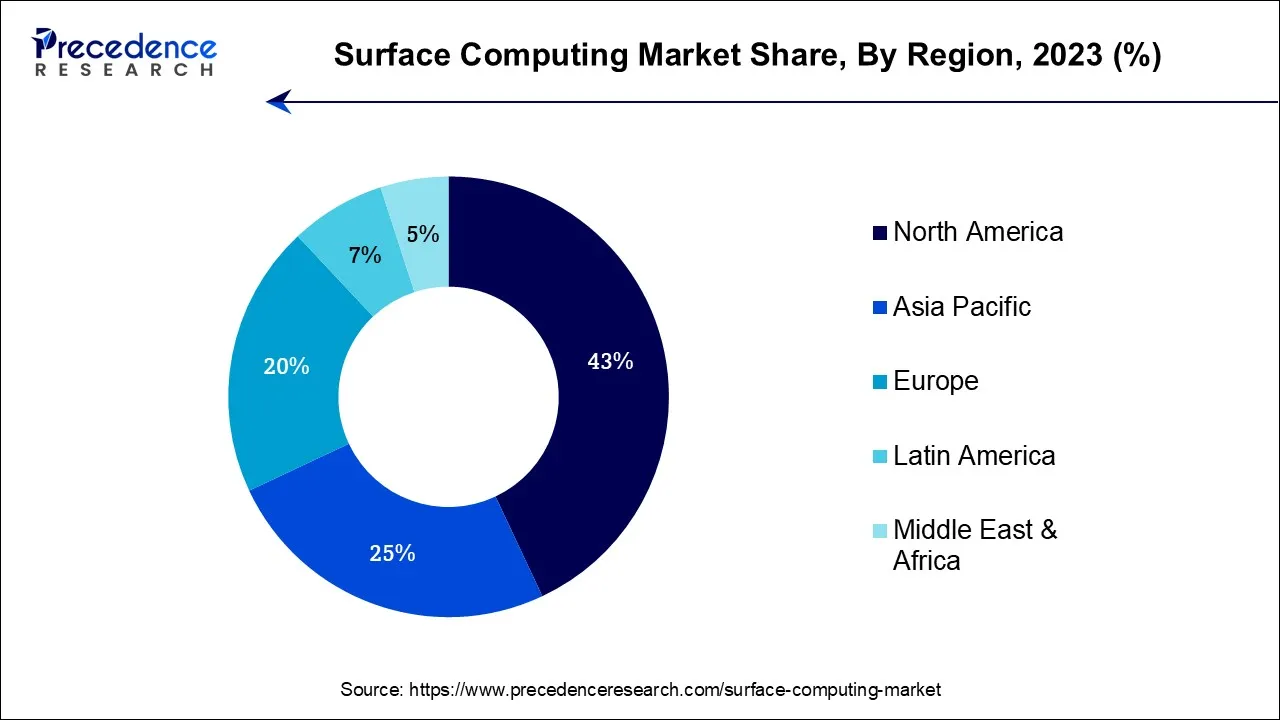List of Contents
Surface Computing Market Size and Forecast 2025 to 2034
The global surface computing market size was valued at USD 86.07 billion in 2024 and is anticipated to reach around USD 1,890.79 billion by 2034, expanding at a CAGR of 36.20% over the forecast period from 2025 to 2034.

Surface Computing Market Key Takeaways
- In terms of revenue, the surface computing market is valued at $117.23 billion in 2025.
- It is projected to reach $1,890.79 billion by 2034.
- The surface computing market is expected to grow at a CAGR of 36.20% from 2025 to 2034.
- North America has captured the largest revenue share of 43% in 2024.
- By Type, the flat display segment contributed more than 63% of revenue share in 2024.
- By Type, the curved display segment is expected to expand at a notable CAGR of 33.1% during the projected period.
- By Touch, the multi-touch segment is anticipated to hold the biggest market share of 39% in 2024.
- By Touch, the single touch segment is anticipated to grow at the fastest CAGR over the projected period.
- By Application, the retail sector segment captured the largest revenue share of 19.9% in 2024.
- By Application, the automotive industry segment is expected to expand at a remarkable CAGR of 30.9% over the predicted period.
- By Vision, the two dimensional segment has registered the maximum revenue share of 59.1 % in 2024.
- By Vision, the three-dimensional segment is predicted to grow at a significant CAGR of 39.8% over the predicted period.
U.S. Surface Computing Market Size and Growth 2025 to 2034
The U.S. surface computing market size accounted at USD 25.91 billion in 2024 and is projected to be worth around USD 579.86 billion by 2034, poised to grow at a CAGR of 36.46% from 2025 to 2034.

North America has held the largest revenue share 43% in 2024.The region boasts a robust technological ecosystem, including advanced research and development, strong infrastructure, and a large pool of skilled professionals. Additionally, North American businesses are quick to adopt innovative technologies, driving demand for surface computing solutions. The presence of major market players and continuous investments in sectors like healthcare, retail, and education contribute to its market leadership. Furthermore, a heightened awareness of the benefits of surface computing and the region's economic stability solidify North America's substantial share in the market.
Currently, North America is dominating the surface computing market. North America holds a well-established technological infrastructure. The early adoption and social acceptance of digitalization and new advancements boost the electronics sector. The rising demand for advanced technologies is fueling growth across regions and among the next generation. Mainly, the retail sector first initiated the contribution by approaching this market.

Asia-Pacific is estimated to observe the fastest expansion due to several compelling reasons. Its robust economic growth has spurred heightened technology investments in diverse sectors like retail, healthcare, and education, driving the demand for interactive solutions. Furthermore, the region's expanding population and urbanization have fueled increased adoption of surface computing systems by both consumers and businesses. Asia-Pacific's prominence as a manufacturing and innovation center further cements its pivotal role in the production and advancement of these systems. Consequently, the region's market presence continues to strengthen, underscoring its noteworthy standing in the global surface computing landscape.
Market Overview
The surface computing market represents the worldwide sector dedicated to creating and marketing interactive computer systems that facilitate direct interaction with digital content by utilizing touch, gestures, and other natural inputs on a tangible surface. This technology finds applications across diverse industries, including retail, healthcare, education, and entertainment, enabling interactive kiosks, digital displays, and collaborative environments. The market has experienced consistent expansion, driven by rising demand for user-friendly interfaces and improved user experiences. It remains in a state of constant evolution, propelled by advancements in touch and gesture recognition technologies, offering prospects for ongoing innovation and growth in the years to come.
Surface Computing Market Growth Factors
The surface computing market revolves around interactive computer systems that facilitate direct interaction with digital content through natural inputs like touch and gestures on tangible surfaces. It caters to various sectors, including retail, healthcare, education, and entertainment, enabling applications like interactive kiosks and collaborative workspaces. The industry's steady ascent is attributed to the surging demand for user-friendly interfaces and enriched user experiences. Ongoing technological advancements in touch and gesture recognition further propel this market, fostering ample room for innovation and expansion.
The surface computing market experiences a series of noteworthy trends and growth catalysts. First and foremost, the widespread adoption of touch-based interfaces in consumer electronics, such as smartphones and tablets, serves as a driving force for touch technology's penetration across various sectors. Simultaneously, the heightened desire for interactive and immersive customer interactions in retail and hospitality fuels market growth, as businesses seek ways to distinguish themselves. The healthcare sector's embrace of surface computing for enhancing patient engagement and information dissemination also significantly contributes to market expansion.
Multiple growth enablers and promising business prospects underpin the surface computing market. The proliferation of Internet of Things devices and smart applications generates demand for inventive human-machine interfaces, creating opportunities for market players to pioneer cutting-edge solutions. Furthermore, the infusion of AI and machine learning into surface computing augments user experiences, offering avenues for technological advancement. Additionally, the post-pandemic landscape has accelerated the need for touchless interfaces across industries, providing fertile ground for business ventures.
Despite its flourishing potential, the surface computing industry encounters its fair share of challenges. One salient hurdle pertains to the imperative need for robust security measures, given that interactive surfaces can be susceptible to data breaches and cyber threats. Safeguarding user privacy and data protection remains a paramount concern. Moreover, the initial high costs associated with implementing surface computing systems may deter certain businesses from adoption. Additionally, issues related to standardization and compatibility between diverse devices and platforms can pose interoperability challenges, impeding seamless integration.
To sum up, the surface computing market promises growth opportunities driven by trends such as the widespread embrace of touch technology, the pursuit of interactive customer engagements, and the integration of surface computing in healthcare. The convergence of AI and IoT, coupled with the growing demand for touchless interfaces in a post-pandemic world, opens up multiple business avenues. Nonetheless, addressing security apprehensions, cost management, and resolving interoperability issues are crucial for sustaining growth in this dynamic sector.
Technological Advancement
Technological advancements in the surface computing market feature 3D vision technology, multi-touch screens, and augmented and virtual reality. The 3D vision technology is an advanced effort to introduce techniques like depth touch, which creates a realistic view. The multi-touch screens connect industries with more engagement through clear interaction. The augmented and virtual reality provide a quality experience to the users. The sustainable display technologies develop more efficient and effective energy. The environmentally friendly factor is approachable. Touchless/gesture-based interfaces support hygiene and safety in public places. AI and machine learning in surface computing systems automate tasks and generate more creative ideas for intelligent interaction.
The market is seeking development and innovation in applications such as industrial automation and smart homes. This advancement will expand the market name and leverage growth in certain industries and emerging areas. This will redesign the future of the surface computing market. The enhancement is double the profit to the market.
Market Scope
| Report Coverage | Details |
| Market Size in 2024 | USD 86.07 Billion |
| Market Size in 2025 | USD 117.23 Billion |
| Market Size by 2034 | USD 1,890.79 Billion |
| Growth Rate from 2025 to 2034 | CAGR of 36.20% |
| Largest Market | North America |
| Base Year | 2024 |
| Forecast Period | 2025 to 2034 |
| Segments Covered | Type, Touch, Vision, Application, and Region |
| Regions Covered | North America, Europe, Asia-Pacific, Latin America, and Middle East & Africa |
Market Dynamics
Driver
User experience enhancement
User experience enhancement is a significant driver of market growth in the surface computing industry. These systems offer a transformative approach to human-computer interaction by allowing users to directly engage with digital content through touch, gestures, and natural inputs. This immersive and intuitive experience is compelling and has wide-reaching implications across various sectors. In retail, interactive touchscreens and kiosks improve the shopping journey, providing customers with product information, personalized recommendations, and engaging experiences, ultimately leading to increased sales and customer loyalty.
In education, surface computing fosters collaborative learning environments, making lessons more interactive and engaging for students. It enables educators to create dynamic, multimedia-rich content that enhances comprehension and knowledge retention. In healthcare, patient engagement is elevated through interactive surfaces, empowering individuals to access health information, treatment plans, and medical records in a user-friendly manner. This, in turn, contributes to better healthcare outcomes and patient satisfaction. Across industries, surface computing systems elevate user experiences, making them more enjoyable, efficient, and effective. This heightened user satisfaction drives demand for these systems, propelling market growth as businesses and organizations seek to leverage the benefits of improved user engagement and interaction.
Restraints
Interoperability issues
Interoperability issues pose a significant restraint to the growth of the surface computing sector. These challenges stem from the complexity of integrating surface computing technology with existing hardware, software, and infrastructure across various industries. Firstly, the lack of standardized protocols and interfaces in the industry can lead to compatibility issues. Different manufacturers may use proprietary technologies, making it difficult to ensure seamless communication and data exchange between devices and systems. This fragmentation can deter businesses from adopting surface computing solutions, as they fear investing in technology that might not integrate effectively with their existing setups.
Secondly, adapting surface computing systems to diverse environments and applications requires tailored solutions. Achieving this often necessitates costly customizations, further adding to the total cost of ownership and complexity. Lastly, interoperability challenges can lead to delays in implementation and potential disruptions in operations, making businesses cautious about adopting surface computing technology. Addressing these issues through industry standards and improved integration solutions will be vital for overcoming this restraint and promoting wider adoption of surface computing systems.
Opportunities
Healthcare transformation
Healthcare transformation is creating significant opportunities in the surface computing industry. As the healthcare sector increasingly embraces digitalization, surface computing offers innovative solutions that enhance patient care, streamline administrative tasks, and improve overall healthcare experiences. Surface computing systems facilitate the development of interactive patient portals, telemedicine platforms, touch-based medical records, and diagnostic tools, revolutionizing healthcare delivery. These technologies empower patients to access vital information, engage in virtual consultations, and actively participate in their healthcare journeys. Furthermore, surface computing systems empower healthcare professionals to efficiently manage patient data, streamline workflows, and enhance collaboration among healthcare teams. The demand for such solutions is poised for significant growth as healthcare institutions aim to enhance patient outcomes, reduce operational expenses, and offer more personalized and convenient healthcare services. This transformative healthcare landscape represents a substantial growth avenue within the market.
Type Insights
According to the Type, the Flat Display sector has held a 63% revenue share in 2024due to its widespread applicability across various industries and consumer electronics. Flat displays, including LCD and OLED screens, are integral components of surface computing systems, enabling interactive touch and visual experiences. These displays find extensive use in retail kiosks, digital signage, educational interactive boards, and healthcare touchscreens. Moreover, the growing demand for visually immersive experiences in entertainment and gaming further drives the dominance of the Flat Display segment, making it a cornerstone of the surface computing system market.
The Curved Display sector is anticipated to expand at a significantly CAGR of 33.1% during the projected period due to its ability to provide immersive and visually appealing experiences. Curved displays offer a wider field of view, enhanced depth perception, and reduced distortion, making them particularly attractive in applications like gaming, entertainment, and simulations. They create a sense of immersion that flat displays cannot replicate. Additionally, curved displays are gaining traction in sectors such as advertising and digital signage, where their eye-catching design and engagement capabilities make them a preferred choice. As a result, the Curved Display segment captures a substantial portion of the market growth.
Touch Insights
Based on the Touch, Multi-touch is anticipated to hold the largest market share of 39% in 2024. The Multi-touch segment holds a major share in the Surface Computing System market due to its widespread appeal and versatility. Multi-touch technology enables users to interact intuitively with digital content, supporting various gestures and inputs simultaneously. It finds extensive applications in consumer electronics like smartphones and tablets, as well as commercial solutions like interactive displays and kiosks. This broad adoption across industries, coupled with the increasing demand for immersive and user-friendly interfaces, has propelled the Multi-touch segment to dominate the market, making it a preferred choice for businesses and consumers seeking interactive and engaging experiences.
On the other hand, the Single Touch sector is projected to grow at the fastest rate over the projected period. The Single Touch segment holds significant growth in the Surface Computing market due to its significant market share, primarily driven by its cost-efficiency and simplicity. Single-touch technology finds widespread acceptance in scenarios where basic touch interactions suffice, such as in ATMs, information kiosks, and certain retail displays. It serves as a budget-friendly option for organizations seeking to implement surface computing solutions, making it accessible to a broader spectrum of industries and businesses. While multi-touch and advanced technologies are gaining ground, the Single Touch segment maintains its stronghold due to its practicality and affordability across a wide array of applications.
Application Insights
The Retail Sector segment held the largest revenue share of 19.9% in 2024due to its ability to enhance customer engagement and drive sales. Interactive touchscreens, digital kiosks, and immersive displays create compelling in-store experiences, offering customers product information, personalized recommendations, and virtual try-ons. Retailers are increasingly using surface computing to differentiate themselves in a competitive market and adapt to changing consumer preferences. Moreover, the demand for touchless interfaces in retail, accelerated by the COVID-19 pandemic, has further fueled the adoption of surface computing systems, solidifying the Retail segment's major share in the market.
The Automotive Industry sector is anticipated to grow at a significantly faster rate, registering a CAGR of 30.9% over the predicted period. The Automotive Industry segment commands a significant growth in the Surface Computing System market due to its increasing adoption of advanced human-machine interface technologies. Surface computing systems are integrated into vehicles to provide intuitive touch and gesture-based controls for infotainment, navigation, and vehicle management systems. This enhances the driving experience, safety, and convenience, aligning with the automotive industry's focus on innovation and user-centric designs. Additionally, the growing demand for connected and autonomous vehicles further drives the need for interactive surfaces, solidifying the automotive sector's prominent position in the surface computing system market.
Vision Insights
The Two Dimensional sector has generated a revenue share of 59.1 % in 2024. The dominance of the Two-Dimensional (2D) segment in the surface computing market is attributed to its well-established position and adaptability. 2D touchscreens, encompassing capacitive and resistive technologies, have enjoyed widespread adoption as the industry norm, finding extensive use in devices like smartphones, tablets, and interactive kiosks. They are favored for their cost-efficiency, dependability, and user familiarity, making them the preferred choice across various applications. Furthermore, continual enhancements in touch sensitivity and precision have sustained their relevance. While emerging 3D and immersive technologies garner attention, 2D touchscreens maintain their stronghold, catering to diverse industries and multifarious use cases.
The Three-Dimensional sector is anticipated to grow at a significantly faster rate, registering a CAGR of 39.8% over the predicted period. The Three-Dimensional (3D) segment holds a major growth rate in the market primarily due to its ability to provide immersive and interactive experiences. 3D surface computing systems offer a heightened level of engagement and realism, making them particularly appealing in industries like gaming, entertainment, and design. They enable users to interact with digital content in a spatial and tangible manner, enhancing user experiences. Moreover, the increasing adoption of 3D technology across various sectors, including healthcare for surgical planning and education for immersive learning, further bolsters its market share, positioning it as a key driver of growth.
Surface Computing Market Companies
- Microsoft
- Dell Inc.
- SAMSUNG
- Apple Inc.
- LG Electronics.
- ViewSonic Corporation
- Lenovo.
- NVision
- Acer Inc.
- Sony Corporation
- Panasonic Corporation
Recent Developments
- In March 2024, Microsoft announced at a digital event the release of two new AI-powered PCs, along with advances in its management portal and the commercial availability of its Microsoft adaptive accessories. The AI-powered Microsoft Surface PCs are a contribution to the surface computing market.
- In 2022 - Samsung unveiled its Odyssey Ark curved monitor at CES 2022. This 55-inch 4K monitor is the largest of its kind offered by the company and is aimed at gamers and professionals.
- In 2021 -Microsoft introduced Thunderbolt ports in its latest surface computers, the first of its products to get the high-speed data transfer technology that is compatible with multiple docking stations. The new port will replace the USB-C ports in previous surface computers that supported only Microsoft's docking stations.
Segments Covered in the Report
By Type
- Curved Display
- Flat Display
By Touch
- Single Touch
- Multi-touch
- Multi-user
- Other Touches
By Vision
- Two Dimensional
- Three Dimensional
By Application
- Education Sector
- Retail Industry
- Automotive Industry Sector
- Commercial Sector
- Entertainment Industry
- Advertising Industry
- Hospitality Sector
- Automotive Industry
- Others
By Geography
- North America
- Europe
- Asia-Pacific
- Latin America
- Middle East and Africa
For inquiries regarding discounts, bulk purchases, or customization requests, please contact us at sales@precedenceresearch.com
Frequently Asked Questions
Ask For Sample
No cookie-cutter, only authentic analysis – take the 1st step to become a Precedence Research client